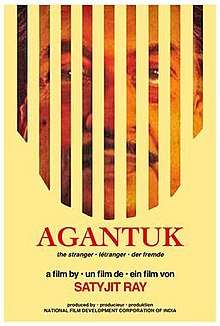Agantuk
Agantuk (lit. 'The Stranger') is a 1991 Bengali-language drama film written and directed by Satyajit Ray.[1] It was Ray's last film, based on one of Ray's own short stories, Atithi. It was a joint Indian-French production with financial backing from companies such as Gérard Depardieu's DD Productions and Canal+.[2]
| Agantuk | |
|---|---|
 Poster | |
| Directed by | Satyajit Ray |
| Produced by | Satyajit Ray |
| Screenplay by | Satyajit Ray |
| Based on | Atithi (short story) by Satyajit Ray |
| Starring | Utpal Dutt Mamata Shankar Deepankar De Dhritiman Chatterjee Promod Ganguli Rabi Ghosh |
| Music by | Satyajit Ray |
| Cinematography | Barun Raha |
| Edited by | Dulal Dutta |
Production company | NFDC DD Productions |
| Distributed by | Artificial Eye (UK) |
Release date |
|
Running time | 120 minutes |
| Country | India France |
| Language | Bengali |
Plot summary
Anila Bose, who lives in Calcutta, receives a letter from someone claiming to be her long lost uncle, Manomohan Mitra. He writes that he is visiting India after 35 years abroad and, as Anila is his only surviving relative, he wants to meet her before he sets off again. Anila looks forward to the meeting, but her husband, Sudhindra, is suspicious. The uncle arrives and stays. He says that he is an anthropologist[3] who has traveled all over the world, and immediately wins the friendship of their son, Satyaki.
Anila suddenly remembers her grandfather's will, and Sudhindra is quick to suspect that the man calling himself Manomohan has come only to claim his share of the inheritance. Anila also starts to doubt his identity, while their son truly believes that he is who he claims to be.
The central conflict of the film rests upon the identity of the man and the family's struggle to determine it. Sudhindra subjects the visitor to various tests. In a final attempt to establish the truth, he invites a lawyer friend to gently question the guest. However, things turn ugly as the lawyer's anger builds up until he orders the guest to "either come clean or just clear out". The next morning, the visitor is gone. Desperate to find him and win him back, the family finally learns that he is in fact Manmohan Mitra, and locate him in a remote village. The couple apologises and persuades him to return. Back in Calcutta, just before he leaves for Australia, Manmohan renounces his share of the inheritance.
Cast
- Deepankar De ... Sudhindra Bose
- Mamata Shankar ... Anila Bose
- Bikram Bhattacharya ... Satyaki Bose
- Utpal Dutt ... Manomohan Mitra / The Agantuk
- Dhritiman Chatterjee ... Prithwish Sen Gupta
- Rabi Ghosh ... Ranjan Rakshit
- Subrata Chatterjee ... Chhanda Rakshit
- Promode Ganguly ... Tridib Mukherjee
- Ajit Bandyopadhyay ... Sital Sarkar
Production
Agantuk was to become Satyajit Ray's last film. He died on 23 April 1992, at the age of 70. The film was a joint Indian-French production with financial backing from Gérard Depardieu's DD Productions, Canal+ and a couple of other French companies.[2] Depardieu is credited as executive producer.[4]
Awards
At the 1992 Indian National Film Awards, Agantuk won the awards for Best Feature Film and Best Directing, and the Special Jury Award went to Mamata Shankar for her portrayal of Anila. At the Ritwik Ghatak awards, it was named the Best Film, while Ray was named the Best Scenario Writer.[5]
Sequel
A stand-alone sequel named Agantuker Pore was supposed to be in production, but has been shelved. Mamata Shankar, Deepankar De and Dhritiman Chatterjee were to reprise their roles from this film. Actor Abir Chatterjee was to play the role of the adult Satyaki. Paayel Sarkar and Tridha Chowdhury were to be seen in important roles.[6] It was supposed to be directed by Orko Sinha, who said the story would be completely different from the previous film.[7]
References
- Surendar Chawdhary (2011). The Pather Panchali of Satyajit Ray: An Illustrated Study. McFarland. p. 192. ISBN 978-0-7864-6353-4.
- IMDb: Company credits for Agantuk Retrieved 2013-05-08
- Satyajit Ray; Bert Cardullo (2007). Satyajit Ray: Interviews. Univ. Press of Mississippi. p. 210. ISBN 978-1-57806-937-8.
- IMDb: Full cast and crew for Agantuk Retrieved 2013-05-08
- ""Agantuk" bags best Bengali film award". The Indian Express. 6 November 1993. p. 23. Retrieved 22 January 2018.
- "Abir, Paayel to star in Agantuker Pore". The Times of India. Retrieved 29 April 2015.
- "Film to revisit Ray's Agantuk". The Times of India. Retrieved 11 April 2015.